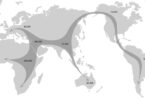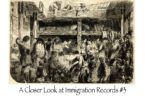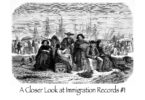During the first three centuries of European immigration to North America, the best, and often the only source of immigration record is the ship manifest. This early ship manifests will be found at the ports of departure in Europe, at the archives of the town, county, or province from which your ancestor departed for America. After towns, cities, counties, and colonial governments were set up and properly organized and operating in America, the ship manifests for arriving ships may be recorded and stored there, as well. If you can find both the departure and arrival records, you can compare them and be sure you are looking at records for the same person or family.
If you can only find one or the other, it is still a good source that will tell you a lot about your ancestor and their trip to the North American continent, as well as their early settlement there, and will give you an idea of where to look for other records on that person or family.
By the mid to late 1800s, there was a federal immigration law in the United States, and records of arriving ships were usually kept in one central location. While there were a few different ports that were commonly used for arriving immigrants, and records of those arrivals may be found in those places, such as Philadelphia and Boston, the primary hub of immigration to America was in New York City at Castle Garden.
Castle Garden was the primary hub of immigration to America from 1820 to 1892. There were more than eleven million immigrants who came through there during that period, and more than one hundred million Americans today can trace their ancestry to someone who arrived at Castle Garden at the Port of New York at the Batter in New York City. There is even a free database online at CastleGarden.org where you can look up your ancestor’s name, and find out the year they immigrated, the name of the ship they came on, and sometimes other information, such as the spelling of their name, their age, their intended destination after arriving in America, their profession, the name of their immigration sponsor (usually an employer) or relative with whom they were going to stay, and occasionally the names of any relatives who they came with on the same ship to America. It is truly a treasure trove of genealogical information in the form of immigration records.
Castle Garden was established at a time when there was a greatly increased number of immigrants to America. Because so many people were cramming into ships to get here, it made for voyage conditions that were not ideal. Many passengers became ill on the trip here, and either arrived ill or crossed to the other side on the way here. The US federal government passed a bill in 1819 to limit the number of passengers on each arriving ship to make the voyage conditions better for those who came here. The US Customs Service was appointed to monitor arriving ships at Castle Garden to make sure they were adhering to the new law.
Because the captains of ships were often unscrupulous, packing in more passengers than the law allowed, and there were also deceptive people in America looking to prey on recent arrivals looking for work and/or lodgings, Castle Garden was made the only port of arrival for ships with immigrants in 1855. Before this, ships might have gone to other ports to avoid the customs officials at Castle Garden.




